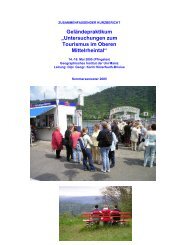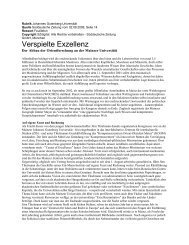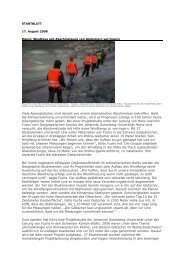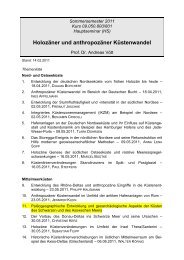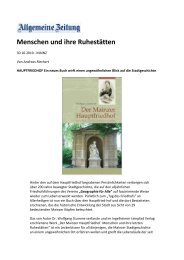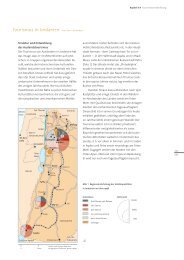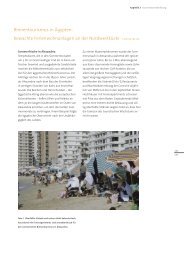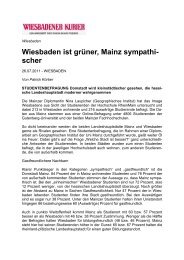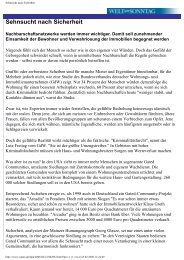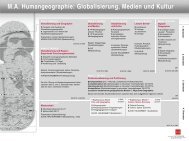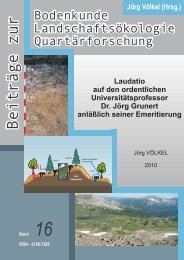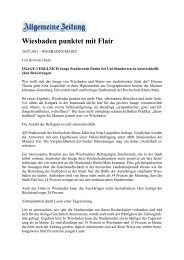Proceedings - Johannes Gutenberg-Universität Mainz
Proceedings - Johannes Gutenberg-Universität Mainz
Proceedings - Johannes Gutenberg-Universität Mainz
You also want an ePaper? Increase the reach of your titles
YUMPU automatically turns print PDFs into web optimized ePapers that Google loves.
2 nd INQUA-IGCP-567 International Workshop on Active Tectonics, Earthquake Geology, Archaeology and Engineering, Corinth, Greece (2011)<br />
EARTHQUAKE<br />
ARCHAEOLOGY<br />
INQUA PALEOSEISMOLOGY<br />
AND ACTIVE TECTONICS<br />
NEOTECTONICS AND COMPARISON OF THE ENVIRONMENTAL SEISMIC INTENSITY<br />
SCALE (ESI 2007) AND THE TRADITIONAL SCALES FOR EARTHQUAKE INTENSITIES<br />
FOR THE KALAMATA (SW GREECE) EARTHQUAKE (MS=6.2R, 13-09-1986)<br />
Fountoulis, Ioannis (1, Mavroulis, Spyridon (1)<br />
(1) National and Kapodistrian University of Athens, Faculty of Geology and Geoenvironment, Department of Dynamic Tectonic<br />
and Applied Geology, Panepistimiopoli, Zografou 15784 Athens, GREECE. Email: fountoulis@geol.uoa.gr , smavroulis@yahoo.gr<br />
Abstract: The Kalamata (13-09-1986, Ms=6.0R, SW Peloponnese) earthquake can be classified as a medium to small scale<br />
event based on the tectonic structures that triggered the earthquake and the effects caused on human, structural and natural<br />
environment. The aim of this paper is to present the geotectonic and seismotectonic regime of the earthquake affected region<br />
based on field data along the seismic fault zone and an attempt is made towards the: (i) estimation of the intensity values<br />
according to the European Macroseismic Scale (EMS 1998) and the Environmental Seismic Intensity Scale (ESI 2007) and the<br />
determination of their geographical distribution in a macroscale, (ii) interpretation of the intensity values data and their distribution<br />
according to the seismotectonic, geodynamic and geotechnical regime, and (iii) conduction of a comparative evaluation review on<br />
the application of both EMS 1998 and ESI 2007. The application of both EMS 1998 and ESI 2007 and the comparative evaluation<br />
of the results indicate that the estimated values of EMS 1998 and ESI 2007 were almost in agreement, despite the fact that the<br />
geographical locations of assessment data were different suggesting that the application and use of both scales appears to<br />
represent a useful and reliable tool for seismic hazard estimation.<br />
Key words: Kalamata, earthquake, neotectonics, environmental effects<br />
INTRODUCTION<br />
Kalamata is located very close (< 70km) to the<br />
Hellenic (Ionian) Trench region in which the<br />
subduction zone of the African plate beneath the<br />
European (Aegean) one exists and thus is one of the<br />
most seismically active areas of Europe (Figure 1).<br />
On 13 September 1986, a shallow depth (< 10km)<br />
earthquake struck the wider Kalamata area resulting<br />
in 20 casualties, extensive damages and many<br />
environmental effects. The epicenter of the main<br />
earthquake was located about 10km NNE of the city<br />
of Kalamata, and its magnitude was Ms=6.2<br />
(Papazachos, et al., 1988). Two days later, a second<br />
shock of Ms=5.4R (Papazachos, et al., 1988)<br />
occurred closer to the Kalamata city at the same<br />
depth. The focal mechanism of the main shock<br />
shows an E-W extension (Lyon-Caen et al., 1987;<br />
Papazachos, et al., 1988).<br />
Seismological studies of Papazachos et al. (1988),<br />
and Lyon-Caen et al. (1988) indicated that<br />
aftershocks defined two clusters and an about 450<br />
west-dipping fault plane. The foci depths of the<br />
seismic sequence were ranging between 11 and<br />
0.9km. Based on the variety of orientations and dips<br />
calculated for the sub-faults activated during the<br />
aftershock sequence, since the analysis of the<br />
northern cluster indicates the existence of two types<br />
of orientation, which are dipping in four different<br />
angles and the southern cluster is characterized by<br />
an almost uniform behaviour activated later in the<br />
sequence, Tselentis et al. (1989) concluded that the<br />
area is tectonically very complex which is in<br />
agreement with the neotectonic structure described<br />
by Mariolakos et al. (1989; 1992, 1993) and<br />
Mariolakos & Fountoulis (1998).<br />
Stiros and Kontogianni (2008) applied two first-order<br />
leveling traverses crossing the wider Kalamata area<br />
and measured subsidence of about 7cm NE of the<br />
Kalamata city in epicentral area of the southern<br />
cluster. The Kalamata earthquake produced a<br />
maximum intensity VIII+ on the IMM or EMS 1992<br />
scale (Elnashai et al., 1987; Gazetas et al., 1990),<br />
while Panou et al. (2004) based on building damages<br />
estimated the intensity up to IX - X for the city of<br />
Kalamata.<br />
The aim of this paper is to present the geotectonic<br />
and seismotectonic regime of the earthquake<br />
affected region based on field data along the seismic<br />
fault zone and an attempt is made towards the: (i)<br />
estimation of the intensity values in terms of the<br />
European Macroseimic Scale (EMS 1998; Grünthal,<br />
1998) and Environmental Seismic Intensity Scale<br />
(ESI 2007; Michetti et al., 2007) and the<br />
determination of their geographical distribution in a<br />
macroscale, (ii) interpretation of the intensity values<br />
data and their distribution according to the<br />
seismotectonic, geodynamic and geotechnical<br />
regime, and (iii) conduction of a comparative<br />
evaluation review on the application of both EMS<br />
1998 and ESI 2007.<br />
GEOLOGY - TECTONICS - NEOTECTONICS -<br />
FAULT ZONES - FAULTS<br />
In the broader Kalamata area the following four<br />
alpine geotectonic units from the lower to the upper<br />
occur (Psonis, 1986; Mariolakos et al., 1993): (a) the<br />
38



